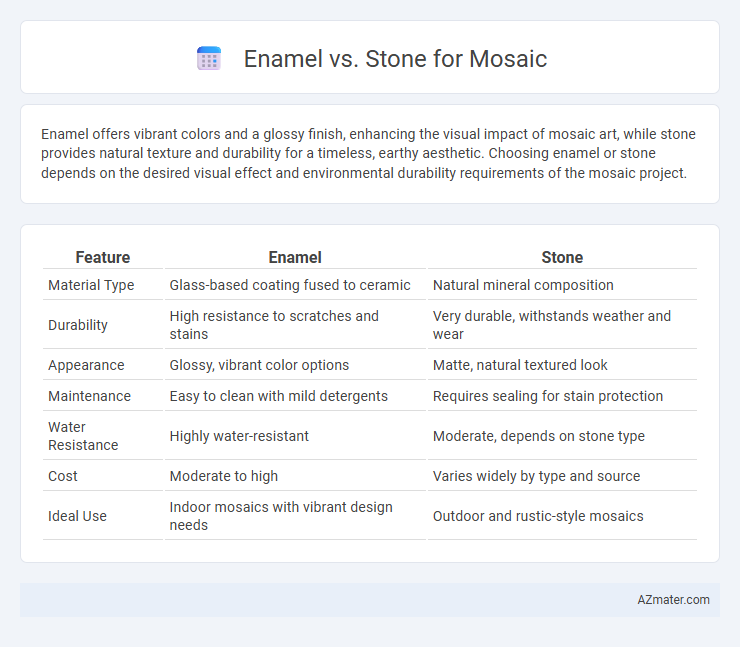Enamel offers vibrant colors and a glossy finish, enhancing the visual impact of mosaic art, while stone provides natural texture and durability for a timeless, earthy aesthetic. Choosing enamel or stone depends on the desired visual effect and environmental durability requirements of the mosaic project.
Table of Comparison
| Feature | Enamel | Stone |
|---|---|---|
| Material Type | Glass-based coating fused to ceramic | Natural mineral composition |
| Durability | High resistance to scratches and stains | Very durable, withstands weather and wear |
| Appearance | Glossy, vibrant color options | Matte, natural textured look |
| Maintenance | Easy to clean with mild detergents | Requires sealing for stain protection |
| Water Resistance | Highly water-resistant | Moderate, depends on stone type |
| Cost | Moderate to high | Varies widely by type and source |
| Ideal Use | Indoor mosaics with vibrant design needs | Outdoor and rustic-style mosaics |
Introduction to Mosaic Art: Enamel vs Stone
Mosaic art utilizes tiny pieces of materials like enamel and stone to create intricate designs characterized by vibrant colors and textures. Enamel, known for its glossy finish and wide color range, offers precise detailing, while stone provides natural durability and earthy tones with textural depth. Choosing between enamel and stone mosaics depends on the desired aesthetic, installation environment, and longevity requirements of the artwork.
Understanding Enamel Mosaics
Enamel mosaics consist of finely ground glass fused onto a metal surface through high-temperature firing, creating vibrant, durable tiles ideal for intricate designs and long-lasting art. The glassy finish of enamel provides intense color saturation and resistance to weathering, making it suitable for both indoor and outdoor installations. Unlike stone mosaics, enamel offers greater flexibility in color variation and intricate detailing, enhancing artistic expression in mosaic projects.
Exploring Stone Mosaics
Stone mosaics offer unparalleled durability and natural texture, making them a preferred choice for long-lasting artistic installations and architectural features. Their diverse mineral compositions create unique color variations and patterns, enhancing the visual depth and tactile richness that enamel mosaics, known for their glossy finish, often lack. Stone mosaics also provide superior resistance to weathering and wear, suitable for both indoor and outdoor applications where durability and authenticity are paramount.
Material Properties: Enamel vs Stone
Enamel for mosaics boasts vibrant colors, a smooth glossy surface, and excellent resistance to fading and water, making it ideal for intricate, durable designs. Stone offers natural texture, varying hardness, and superior durability but may lack the bright color range and uniformity of enamel. Both materials provide unique aesthetic and physical properties, with enamel excelling in color brilliance and stone in rugged, timeless appeal.
Aesthetic Differences in Mosaics
Enamel mosaics offer vibrant, glossy surfaces with rich, translucent colors that reflect light and create a jewel-like appearance, enhancing intricate designs with a luminous quality. Stone mosaics present a natural, textured aesthetic characterized by earthy tones and matte finishes, imparting a timeless, organic feel to the artwork. The choice between enamel and stone significantly influences the overall visual impact, with enamel emphasizing brilliance and color intensity, while stone provides depth and a rustic elegance.
Durability and Longevity Comparison
Enamel mosaics offer high resistance to stains and scratches due to their glass-like surface, ensuring vibrant colors remain intact over time. Stone mosaics are renowned for their natural toughness and ability to withstand heavy wear, often increasing in character with age and exposure. While enamel excels in color longevity and ease of cleaning, stone provides superior durability in high-traffic or outdoor environments, making each suitable depending on application demands.
Design Flexibility and Techniques
Enamel offers superior design flexibility in mosaic art with its vibrant color range and ability to achieve translucent effects, enabling intricate patterns and fine details. Stone mosaics provide a natural, textured aesthetic with durable, earthy tones but require more precise cutting and limited color variations, restricting elaborate designs. Techniques for enamel mosaics include kiln firing and layering for depth, while stone mosaics rely on careful shaping and adhering of tesserae to create strong, long-lasting compositions.
Cost and Accessibility of Materials
Enamel mosaic tiles generally cost more due to their handcrafted nature and specialized production process, making them less accessible in standard hardware stores compared to stone tiles. Stone mosaics, including marble and granite, offer a broader range of price points and are widely available from most suppliers, providing an affordable and versatile option. Material accessibility and budget constraints heavily influence the choice, with enamel favored for aesthetic uniqueness and stone preferred for cost-effectiveness and availability.
Popular Applications in Modern Art
Enamel and stone are popular materials in modern mosaic art, each offering distinct aesthetic qualities and durability. Enamel provides vibrant colors and a glossy finish ideal for intricate designs and contemporary installations, while stone lends a natural, textured appearance perfect for outdoor murals and architectural features. Artists often combine both materials to achieve contrast and depth, enhancing the visual impact in galleries, public spaces, and urban art projects.
Choosing the Right Material for Your Mosaic
Choosing between enamel and stone for your mosaic depends on durability, aesthetic, and installation environment. Enamel offers vibrant colors and a smooth, glossy finish ideal for indoor decorative mosaics, while stone provides natural texture, strength, and weather resistance suited for outdoor projects. Prioritize enamel for intricate color details and stone for robust, long-lasting surfaces in high-traffic or exterior spaces.

Infographic: Enamel vs Stone for Mosaic
 azmater.com
azmater.com